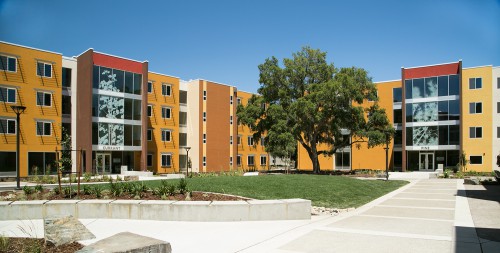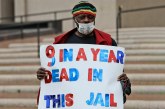
Last week, state legislation that could have repealed a law that prohibits cities and counties from implementing most new rent control measures died after four members of the Assembly Housing and Community Development Committee, including Democrats Ed Chau of Arcadia and Jim Wood of Healdsburg, declined to support it.
They expressed concern that rent cpntrol could slow what is the primary problem in the state – lagging housing production.
“I’m concerned that the bill does nothing to increase the supply of housing and may in fact have the opposite effect of discouraging new construction during a time when we need it the most,” Assemblymember Wood said.
I have yet to see a hard local proposal, but I know the sentiment for rent control is creeping just below the radar in Davis as well. The driver here is clear – the cost of housing is spiraling out of control in many locations and the result is many housing advocates are pushing for rent control as a bandaid to the larger problem.
The LA Times reported: “Tenant advocates chanted ‘housing is a human right’ in the hallways while landlords pleaded to committee members about the effects of expanding rent control on their livelihoods.”
I am not opposed to rent control on its merits. For all of the talk about rent control slowing lagging housing production, the fact remains that the cost of housing is largely created by scarcity of supply rather than necessarily the cost of production.
This past week, we heard from numerous students complaining about the low vacancy rate making renters vulnerable to absentee or even predatory landlords. The city has taken steps to better protect renters through its inspection program and ordinance.
However, at the end of the day, both affordability and quality control are the functions of supply. Give us enough supply and the homes that are poorly maintained will be vacated and, in the age of social media and Yelp, will not likely be rented in the future.
The solution to affordability may not be rent control but rather a functioning market. And the good news is that we are finally starting to move in the right direction here.
The chancellor this week announced for the first time that UC Davis would increase their on-campus student housing allotment from 6200 to 8500 new beds for students.
Writes UC Davis on the Campus Tomorrow page: “The proposed LRDP housing capacity significantly exceeds potential enrollment growth associated with the LRDP. The Plan provides capacity for an additional 8,500 students in campus housing; about 1,000 students in residence halls and about 7,500 students in apartments. In 2016-17 about than 9,800 students lived on campus; about 5,500 traditional first-year students (freshmen) lived in residence halls and another 4,300 upper-division undergraduate and graduate students lived in apartments. The Plan provides capacity to nearly double the overall housing population on campus and almost triple the number of non-freshmen living on campus in apartments; this is the most ambitious student housing plan in the history of UC Davis.”
This was big news. There are people who would like to see the campus get to 10,000 new beds, which would push the amount of on-campus housing to half the student population. But the biggest factor may be the combined total of on-campus and proposed off-campus housing now gets us to between 13,000 and 14,000.
Let us put this into practical terms. Last year, we calculated that we needed about 10,000 beds combined, between the university and the city, to alleviate the housing crisis that sees rents rising 
at roughly eight percent each year (triple inflation) and a 0.2 percent vacancy rate.
By going up to 13,000 to 14,000 beds, we have a real chance to reach a city goal of five percent vacancy. At five percent, we would have a very healthy vacancy rate. Students can move as needed. Problems in specific rental units would result in renters leaving those units for other better units. That will force landlords to have to either keep their units at spec or face the loss of revenue from rent.
A big factor is that it will reduce the incentive for students to live in houses, doubling and tripling up in their rooms. It will reduce the stress on single family homes, on neighborhoods, and eventually it will lead to a glut in the market as the supply expands much faster than renters can adjust their behavior.
I spoke to one longtime apartment manager last week, who believes the result of a large amount of housing coming on line simultaneously will create probably a five-year period where there is more supply than demand. Part of that is due to the fact that a number of students by necessity have moved into single-family homes – crowding in. Another group have rented outside of town.
Eventually the availability of supply will change people’s behavior as they will no longer have to crowd into single-family homes. And they will no longer have to live out of town.
The key, though, is that the supply will drastically change the market. The widening vacancy rate will mean that prices that have been on a long and steep upward trajectory can drift downward.
I would argue that the best way, then, to control rents is by ensuring that we keep and maintain a five percent vacancy rate in town.
This isn’t just on the city. The university has a huge role to play here too. As many know, the university has agreed in the past to increase their housing on campus and then reneged. The 8500 units will not help solve the problem unless they get built.
The immediate plans are in the works for expanding housing at two sites. In 2016-17, West Village accommodated about 2000 students with housing. The current plan is for an additional 3800 students with the possibility of an additional 550 students which would be “accomplished through a ‘double-up’ where existing large bedrooms, previously leased as individual rooms, may be leased as shared bedrooms.”
Meanwhile, at Orchard Park there were 1350 in 2016-17, with the LRDP calling for another 1400 students through the redevelopment of Orchard Park Apartments. “The redevelopment is oriented towards graduate students and students with families. Additional capacity for student housing will be realized when new greenhouse facilities are built further south near the Bowley Plant Science Teaching Facility and the existing greenhouses near the Student Health and Wellness Center are redeveloped.”
Thus, just between West Village and Orchard Park, 5200 of the 8500 beds are planned to be built.
We know that, in the future, enrollment is likely to continue to increase. We also know that the current housing crisis took about 15 years to really manifest, with the lack of new market rate student housing in the city combined with a lag in university-promised housing at places like Orchard and West Village.
To make this solution permanent, both the city and university need to be vigilant. The bottom line for me is that, as long as we can maintain a five percent vacancy rate, the need for rent control and other extraordinary measures is reduced. That should be our focus and that will be what enables us to avoid more cumbersome policy decisions.
—David M. Greenwald reporting







Ultimately, cities such as Davis have a choice to make.
You either let market forces dictate the amount of growth/development that’s approved, or you don’t. (That goes for both rental and for-sale housing.)
The Vanguard clearly believes that market forces should dictate the amount of growth/development that should be built. (And, that goes for what UCD is unilaterally imposing on the city.)
Ironically, the entire region (including Sacramento and Stockton) have recently had the fastest-growing rents in the nation. And, those cities do not have much “growth controls”.
As a side note, planning via vacancy rate is not good policy for a variety of reasons, nor is it likely to work.
Not sure of the last time that Davis had a 5% vacancy rate. But, what this means is that the Vanguard is advocating for new developments that would be (on average) 95% occupied. It’s an advocacy for increasing the size of the city, to obtain 5% empty residences.
“Not sure of the last time that Davis had a 5% vacancy rate. But, what this means is that the Vanguard is advocating for new developments that would be (on average) 95% occupied. It’s an advocacy for increasing the size of the city, to obtain 5% empty residences.”
City goal is 5 percent vacancy. That’s based evidently on studies that show that healthy. Evidence to the contrary?
Pretty much never in the last 25 years. 5% is a good aspiration, but 2 – 3% would be a big improvement.
David’s question shows that he continues to be singularly focused on a “symptom”, vs. the “root cause” (failure to confront UCD). I’ve previously noted some possible options/examples to address the root cause, and to resolve the situation in a more permanent manner (which would likely benefit both student and non-student renters, and the city as a whole).
Sacramento and Stockton have some of the fastest rising rents because those cities–Stockton in particular–suffered the biggest hits to housing values in the Great Recession. Housing values there are now starting to catch up with the rest of the state, which means values and rents have to rise faster than the average of elsewhere. It’s simple math.
And I’ve said this before about Davis–an important reason why our town has a unique ambiance is because the rest of the state taxpayers finance a major university in our midst. In return, we have an obligation to accept the students that the state has assigned to our campus. UCD is not a major corporation–it is a government institution that benefits all of us. We are not in a position to impose growth controls that “close the gate” because that means obstructing opportunities for others elsewhere in the state.
Richard: Most of the growth (regarding UCD’s plans) is due to their pursuit of non-resident students (who pay full tuition costs, as would be required at a private university). This has been noted multiple times, on the Vanguard.
By the way, do we know the amount of the developer’s contribution, and the city’s contribution for the two bicycle/pedestrian overpasses that are needed for Lincoln40? Or, is the city going to figure this out, after (possibly) approving the development?
I realize that the city is hoping to obtain a grant, for a portion of the costs.
[moderator: this is off topic]
Not off topic: Owners who contribute to sustainable transport infrastructure that allows residents to save money on transportation… etc.
Ron: One crossing to Davis Depot-Downtown and the other taking pedestrians and cyclists on Olive over Richards?
Some kind of rent control is needed until we reach that holy grail of 5%, when it can be re-evaluated. And landlords who provide substandard housing should be prosecuted.
Berkeley’s rent control board costs the City $5 million per year. That’s an expensive band-aid.
Source for the $5 million figure?
Berkeley City Budget. Available online.
I found the SF budget online and see that they spend over $8 million a year on their “Rent Arbitration Board”…
Mark: Arey ou saying the administration of the program costs $5 million?
No, that is what the City’s budget document says.
https://www.cityofberkeley.info/uploadedFiles/Manager/Budget/FY%202018%20%20FY%202019%20Proposed%20Budget%20Book.pdf
Page 237
$5 million and 22 FTE.
Interesting: https://www.cityofberkeley.info/Rent_Stabilization_Board/Department_Master_and_Collections/TEMP_-_About_Us_and_Contact_Us/Rent_Board_-_About_Us.aspx
Yes, rent control administration is always expensive in the locations that it is imposed, based on my professional experience working on housing issues.
That further segments my view that rent control is problematic and that we ought to aim for market based solutions here.
And no, I’m not opposed on principle to regulatory solutions if warranted.
First, I think rent control is a bad idea simply because in every instance I’ve encountered it it has produced pronounced market distortions without benefiting those who need it most. Second, I think it makes a poor short-term solution, as I don’t think it would allow the city to roll back rents; restrictions on future increases seems like the best-case result. Third, I believe that a healthy market is always going to be less expensive and more effective than rent control.
And then, of course, there’s the statutory bar to new rent control ordinances that appears to be standing on the way
A missing part of this discussion are the people who have been displaced by rising rents in the last several years. A healthy rental market will allow them to return and reduce the traffic from commuting into Davis, and everything that comes with it.
That’s a big point I’ve made when we argue about traffic impacts for projects, the traffic analysis doesn’t take into account the reduction of traffic as the result of the new development being in non-car distance from campus.
Sean:
If you know anyone that works 5 days a week in Davis that moved out town to save money on rent you should have them crunch the numbers on driving using the AAA average of ~$0.60/mile.
http://newsroom.aaa.com/tag/driving-cost-per-mile/
While rents are cheaper in Rancho Cordova or Fairfield ~25 miles away the are not typically $600/month cheaper.
Even the relatively short drive to Dixon, Woodland or West Sac will probably cost more in gas and wear and tear on the car (as a young person I would often “forget” how each mile is not just what is costs in gas but in wear and tear that brings you closer to the next clutch, set of tires or brake pads and also makes your car worth a lot less when you sell it) than you save on rent (plus you will have a lot more free time and can even ride your bike to work if you live in town).
It is also important to remember that while new homes and apartments will put downward pressure on rents and sale prices it won’t bring back the $350/month rents and $75K homes sale prices from early 80’s Davis due to inflation.
P.S. I walked by the new Philz Coffee downtown today and it is no wonder people have a hard time affording the rents in town when they are paying $3.50 to $7.00 for a single cup of coffee. There were so many people in the store today (with a line out the door) that I thought that they must be giving coffee away for free. I don’t want to go “Suze Orman” on the kids but making coffee at home costs under a dime a cup (using good beans). If I brew a pot of Starbucks Medium for ~$0.70 a pot (10 cups) every day and a hipster gets a single cup of Philz Jamaican Blue Mountain for $7.00/cup it will start to add up to real money after a while (just like all those $10 bottles of super hip “craft” beer)…
That is not the incremental cost for someone who already owns a car. Also, there’s plenty of Davis residents who drive within Davis.
So, what is the incremental cost? Source?
I’d like to know what Ken’s (AAA) number includes.
In all honesty, I’m speaking from personal experience (older/compact but reliable vehicle, relatively cheap registration costs, no insurance for damage to the vehicle itself, good driving record, etc.). I also recall a government reimbursement rate that was less than that (but it was some time ago).
Fair enough, though. I probably should present something to support it. (Not sure it’s worth arguing it, though. Just seems very high, given my own experience.)
IRS allows offsets to income @ ~ $0.54/mile for business use (2017). They do not differentiate by make/model/age/condition of vehicle.
If one has a car already, the incremental cost of driving a mile is likely different.
If one specifically purchases a car (in order to drive XX miles per year), that’s likely what the AAA and IRS rates are based upon. An allocation of costs, some of which would occur even if the car was not driven XX miles per year.
Probably didn’t word that quite right. But again, I strongly suspect that this isn’t the incremental cost. It’s probably an allocated portion of all costs, some of which would occur without even driving it (solely resulting from ownership, if one already has a car).
You are incorrect, Ron. And IRS doesn’t account for state (affects gas prices)… or higher insurance rates in CA… it is based on aggregated numbers.
$0.60/mile may be a tad high, but probably reasonable, if not applicable to anyone’s specific situation. IRS is not known to be ‘generous’ in allowances.
You are correct on one aspect… it is not worth arguing about. Which is why I was surprised that you challenged the $0.60 mile figure. To what purpose?
Well, if you’re saying I’m incorrect, then what exactly is included in the AAA or IRS calculations? I took a quick look, and have not found what costs are included.
Regarding the reason – I’m interested in accuracy, as I believe that you are when making arguments. It probably is good to know this, when comparing rents in nearby areas (as Ken mentioned, for example).
Since Davis is not a “closed market”, rental rates in nearby areas have an impact on rental rates in Davis.
Howard:
Actually, it looks like you’re wrong (regarding IRS mileage rates):
https://www.reference.com/business-finance/irs-calculate-mileage-rate-1bffac9d01a6ba28
Aggregated…
https://www.calif.aaa.com/automotive/advocacy/cost-of-driving.html
Many variables…
Cost per mile for fuel, and wear and tear (repair/maintenance) is much higher for short trips (25 miles or less)… cold starts, lack of full engine lubrication, more frequent starts/stops/idling. [Seem to recall that 40% of damages/costs to car occurs in the first 25 miles of a trip from SF to LA. Except of course, for fuel, and even then, the fuel efficiency is also less/mile during the first 25 miles.]
‘Depreciation’ is a weird function of mileage/age… I’d pay more for a newer car with high mileage (odometer), than an older car with low mileage… would not buy a used car that was only driven for short trips over a long period of time.
Could it be that you want complete details so that you could poke holes in individual line items? Will assume not, that you meant it as an honest question…
Howard:
The information/link you provided does not actually show how AAA calculates its cost of mileage.
However, your link does show that the cost of driving a new car 15,000 miles is $8,469. ($8,469/15,000 = 56 cents/mile.) Your link also shows that depreciation (which would occur even if a car is not driven) is the largest cost.
It appears that you are wrong about both the IRS and AAA rate, regarding how they’re calculated. And, that my original statements are correct.
I am not advocating that anyone “commute” to/from Davis. However, I suspect that many do so, to obtain cheaper housing options. And, that costs/availability in nearby areas impacts both the vacancy rate (and cost) of renting or purchasing in Davis.
This is really getting pretty far off topic, folks.
Moderator: It’s loosely related, since Davis is not a closed market and is impacted by markets in surrounding communities, in more than one way. Regarding who is personally “right” or who is “wrong”, that’s far less important. But again, the cost of driving/mileage appears to be quite a bit cheaper than originally cited, if one already owns a car. (That was my only point, regarding this thread.) And, I’m glad that (during this communication) we uncovered evidence to show that point.
Ken, when I say displaced, I am not talking about just the folks displaced by rising rents, Im talking about people who literally get no fault evicted or landlords refuse to renew leases, sell the place etc etc.
Regarding Berkeley’s rent stabilization program, the following is from the link that Mark provided, above. It appears that the program is more comprehensive than it first appears, and includes protection against unwarranted evictions, for example.
RENT STABILIZATION PROGRAM
Composed of nine elected commissioners, the Rent Stabilization Board enacts regulations, hears petition appeals and administers a program to implement the Rent Stabilization and Eviction for Good Cause Ordinance that regulates most residential rents in Berkeley, provides tenants with increased protection against unwarranted evictions and is intended to maintain affordable housing and preserve community diversity. (Berkeley Municipal Code Chapter 13.76.)
The Rent Stabilization Program provides information and counseling to over 10,000 landlords and tenants annually, calculates and certifies individual rent ceilings, maintains a database of registered rental units, collects registration fees, and conducts administrative hearings and issues decisions on landlord and tenant rent adjustment petitions. Owners of rental property covered by the Ordinance are required to register their units with the Program by filing registration statements and paying annual registration fees, which cover the program’s cost.”
Using Mark’s referenced number ($5 million), the 10,000 units cited would be charged $500 each/annually. (Perhaps not such a “bad deal”, even if that cost was passed on to each renter.) Especially since the program helps prevent unwarranted evictions.
I suspect that renters in Berkeley do not view this program as a “band-aid”. Wonder if the Vanguard has asked renters in Berkeley, S.F., and other rent-controlled cities how they view such programs.
On a related note, I’ve personally witnessed situations in which rent control resulted in a monthly rental rate which is far below market rates, even though administrative costs associated with rent control programs can (apparently) be passed on to renters. (An extreme difference, vs. unrestricted market rates.) Also, unlike Affordable housing, rent control is apparently not subject to caps regarding income.
If the Vanguard is going to take a position regarding rent control, perhaps David could (first) interview some beneficiaries of it, as well as owners of such properties in rent-controlled cities to determine how well it’s working.
Rent control in NY has income limits but I do not know of any CA towns with income limits (a friend that lives in Hillsborough still has the SF Bay View rent control apartment that they use a few times a month (and let poor friends from Davis use when they drive to events in SF)…
For long-term renters in particular, rent control appears to be a far more effective method of keeping rents in check, vs. “building our way” to affordability. There is evidence of this in cities such as San Francisco and Berkeley (where there is nevertheless/also a lot of new housing construction going on).
As noted above (regarding Berkeley), the cost of the “rent stabilization program” is borne by property owners – not the city at large.
What we are building our way to is meeting demand for housing from students, if meeting that demand between the university and the city helps stabilize rent, then that’s a bonus.
Again, without some type of formal agreement between the city and UCD, this is just “pissing into the wind”. And, doesn’t provide the type of housing needed for non-students, while simultaneously displacing sites used for social services, industrial, or commercial development. And, without even creating sufficient revenue to offset its own costs to the city.
Not my idea of sound planning.
Nothing beats rent control, to keep rents in check for long-term renters. This has already been demonstrated in cities that have it. Suggest that you ask some folks who have directly benefited from it.
Interesting ‘conflation’ of “spitting into the wind” (having it come back on yourself, usually in one own’s face), and “pissing into the ocean” (doesn’t hurt you, but has extremely negligible effect). Interesting mixed metaphor…
End of “drift”…
You and every Uber/Lyft driver out there today.
Exactly